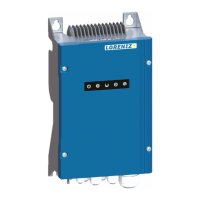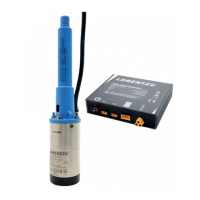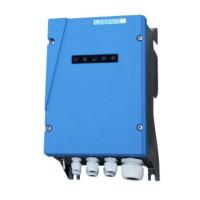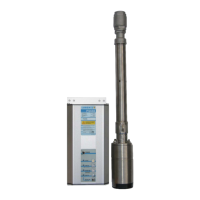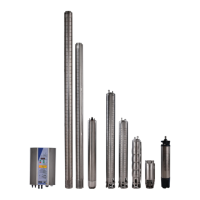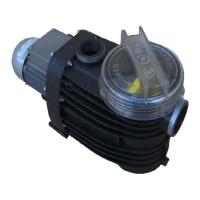Potential problems with the low-water probe in
surface water The probe has a moving float. It is highly
resistant to deposits and debris. However, it may stick
under some extreme conditions, especially from algae or
water creatures (snails, etc.) that may be present in surface
water.
Possible solutions are:
Hang the probe independently of the pump and pipe 1.
(clamped to a weight, but not to the drop pipe). This
way, it can be pulled up for inspection or cleaning
without the need to pull the pump. (This may not be
feasible if the well casing is smaller than 6 in.)
Pull the probe out periodically (with the pump if nec-2.
essary) for testing and inspection. The pump should
stop at the moment the probe leaves the water.
Wrap the probe in a protective screen (fiberglass 3.
window screen, for example). Substitute a different
type of float switch. You can use any switch that
makes contact on rise (normally open).
WARNING Running completely dry
will damage the pump and void the
warranty. The purpose of the probe
system is to sense the loss of water
and turn the pump off before it can
run dry.
CAUTION The low-water probe must
be positioned vertically, within 10°. If
the pump is NOT to be installed
vertically, find an alternative way to
mount or suspend the probe, so that
it is higher than the pump, and in a
vertical position.
CAUTION Do not use a pressure
switch with a “low water cutout” or
“loss of prime” feature as a method
of dry-run protection. A helical rotor
pump will maintain pressure as it
runs dry, so this method will not
work reliably. For pressure switch
information, see section 5.12,
Pressurizing Systems
Low-water probe installed in the Figure 9:
standard position, for a pump that is positioned
vertically
Low-Water Probe for Dry-Run Protection4.9
Installation The probe is packed with two stainless steel
hose clamps. For a pump that is to be installed in a vertical
position, clamp it to the pipe just above the pump outlet,
as shown in the photo. Splice the two probe wires using
the splice kit components that are packed with the probe.
The assembly procedure is the same as the main pump
splice.
If you are NOT using the well probe, it must be
bypassed. Connect a short wire between the probe ter-
minals in the junction box (terminals 1 and 2). Do this only
if you feel certain about the reliability of the water source.
Wire size: #18 AWG (1 mm
2
) or larger.
Principle of operation The probe contains a mechanical
float with a magnet inside. When the probe is submerged,
the float rises, and the magnet actuates a switch. The
switch closes (makes contact) to indicate the presence of
water. The switch is sealed, so the contacts never touch the
water.
If the water level drops below the probe, the float drops,
and the switch opens (breaks contact). The controller will
stop the pump and the “Low-Water OFF” light will indicate.
When the water level recovers and switch closes again, the
controller will delay the restart for 20 minutes. This gives
time for the water level to recover. To force a quick restart,
turn the controller off, then on again.
NOTE Pumps made before October 2003 may have
a different type of probe, with wet electrodes.
Either type can be used with the PS series control-
lers.
The Low Water-OFF light flashes slowly for the
remainder of the day, even if the water recovers and the
pump restarts automatically. This tells you that the water
source ran low at least once since the power was disrupted
(or sun went down). To turn the light off, reset the control-
ler by turning it off/on.

